London Bridge Is Falling Down
"London Bridge Is Falling Down" (also known as "My Fair Lady" or "London Bridge") is a traditional English nursery rhyme and singing game, which is found in different versions all over the world. It deals with the depredations of London Bridge and attempts, realistic or fanciful, to repair it. It may date back to bridge rhymes and games of the Late Middle Ages, but the earliest records of the rhyme in English are from the seventeenth century. The lyrics were first printed in close to their modern form in the mid-eighteenth century and became popular, particularly in Britain and the United States during the 19th century.
| "London Bridge Is Falling Down" | |
|---|---|
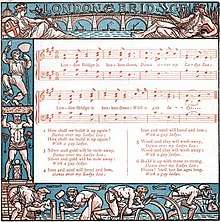 Illustration from Walter Crane's A Baby's Bouquet (c. 1877). | |
| Nursery rhyme | |
| Published | c. 1744 |
| Songwriter(s) | Unknown |
The modern melody was first recorded in the late nineteenth century and the game resembles arch games of the Middle Ages, but seems to have taken its modern form in the late nineteenth century. It has a Roud Folk Song Index number of 502. Several theories have been advanced to explain the meaning of the rhyme and the identity of the "fair lady" of the refrain. The rhyme is one of the best known in the world and has been referenced in a variety of works of literature and popular culture.
Lyrics
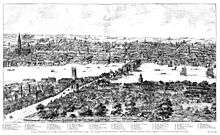
_by_Claes_Van_Visscher.jpg)

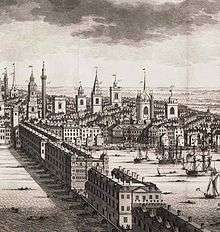
.jpg)
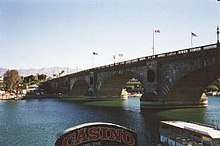

There is considerable variation in the lyrics of the rhyme. The most frequently used first verse is:
London Bridge is falling down,
Falling down, falling down.
London Bridge is falling down,
My fair lady.[1]
In the version quoted by Iona and Peter Opie in 1951 the first verse is:
London Bridge is broken down,
Broken down, broken down.
London Bridge is broken down,
My fair lady.[2]
The rhyme is constructed of quatrains in trochaic tetrameter catalectic,[3] (each line made up of four metrical feet of two syllables, with the stress falling on the first syllable in a pair; the last foot in the line missing the unstressed syllable), which is common in nursery rhymes.[4] In its most common form it relies on a double repetition, rather than a rhyming scheme, which is a frequently employed device in children's rhymes and stories.[5] The Roud Folk Song Index, which catalogues folk songs and their variations by number, classifies the song as 502.[6]
Melody
The melody now most associated with the rhyme.
A melody is recorded for "London Bridge" in an edition of John Playford's The Dancing Master published in 1718, but it differs from the modern tune and no lyrics were given. An issue of Blackwood's Magazine in 1821 noted the rhyme as a being sung to the tune of "Nancy Dawson", now better known as "Nuts in May" and the same tune was given in Richard Thomson's Chronicles of London Bridge (1827).[2]
Another tune was recorded in Samuel Arnold's Juvenile Amusements in 1797. E.F. Rimbault's Nursery Rhymes (1836) has the same first line, but then a different tune.[1] The tune now associated with the rhyme was first recorded in 1879 in the United States in A.H. Rosewig's Illustrated National Songs and Games.[7]
The game

The rhyme is often used in a children's singing game, which exists in a wide variety of forms, with additional verses. Most versions are similar to the actions used in the rhyme "Oranges and Lemons". The most common is that two players hold hands and make an arch with their arms while the others pass through in single file. The "arch" is then lowered at the song's end to "catch" a player. In the United States it is common for two teams of those that have been caught to engage in a tug of war.[2] In England until the nineteenth century the song may have been accompanied by a circle dance, but arch games are known to have been common across late medieval Europe.[1]
Five of nine versions published by Alice Gomme in 1894 included references to a prisoner who has stolen a watch and chain. This may be a late nineteenth century addition from another game called "Hark the Robbers",[8] or "Watch and Chain". This rhyme is sung to the same tune and may be an offshoot of "London Bridge" or the remnant of a distinct game. In one version the first two verses have the lyrics:
Who has stole my watch and chain,
Watch and chain, watch and chain;
Who has stole my watch and chain,
My fair lady?
Off to prison you must go,
You must go, you must go;
Off to prison you must go,
My fair lady.[1]
.jpg)
Origins
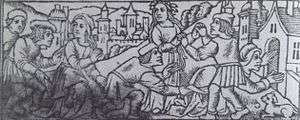
Similar rhymes can be found across Europe, pre-dating the records in England. These include "Knippelsbro Går Op og Ned" from Denmark, "Die Magdeburger Brück" from Germany, "pont chus" from sixteenth-century France; and "Le porte", from fourteenth-century Italy. It is possible that the rhyme was acquired from one of these sources and then adapted to fit the most famous bridge in England.[2]
One of the earliest references to the rhyme in English is in the comedy The London Chaunticleres, printed in 1657, but probably written about 1636,[9] in which the dairy woman Curds states that she had "danced the building of London-Bridge" at the Whitsun Ales in her youth, although no words or actions are mentioned.[1] Widespread familiarity with the rhyme is suggested by its use by Henry Carey in his satire Namby Pamby (1725), as:
Namby Pamby is no Clown,
London Bridge is broken down:
Now he courts the gay Ladee
Dancing o'er The Lady-Lee.[1]
The oldest extant version could be that recalled by a correspondent to the Gentleman's Magazine in 1823, which he claimed to have heard from a woman who was a child in the reign of Charles II (r. 1660–85) and had the lyrics:
London Bridge is broken down,
Dance over the Lady Lea;
London Bridge is broken down,
With a gay lady (la-dee).
The earliest printed English version is in the oldest extant collection of nursery rhymes, Tommy Thumb's Pretty Song Book, printed by John Newbery in London (c. 1744), beginning with the following text:
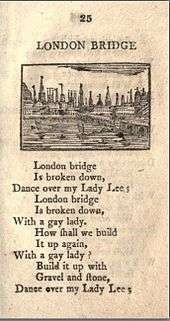

London Bridge
Is Broken down,
Dance over my Lady Lee.
London Bridge
Is Broken down
With a gay Lady.[2]
A version from James Ritson's Gammer Gurton's Garland (1784) is similar but replaces the last verse with:
Build it up with stone so strong,
Dance o'er my Lady lee,
Huzza! 'twill last for ages long,
With a gay lady.[2]
Meaning
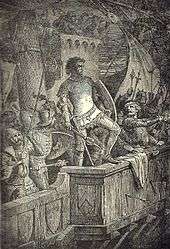
The meaning of the rhyme is not certain. It may simply relate to the many difficulties experienced in bridging the River Thames, but a number of alternative theories have been put forward.
Viking attack theory
One theory of origin is that the rhyme relates to the supposed destruction of London Bridge by Olaf II of Norway in 1014 (or 1009).[10] The nineteenth-century translation of the Norse saga the Heimskringla, published by Samuel Laing in 1844, included a verse by Óttarr svarti, that looks very similar to the nursery rhyme:
London Bridge is broken down. —
Gold is won, and bright renown.
Shields resounding,
War-horns sounding,
Hild is shouting in the din!
Arrows singing,
Mail-coats ringing —
Odin makes our Olaf win!
However, modern translations make it clear that Laing was using the nursery rhyme as a model for his very free translation, and the reference to London Bridge does not appear at the start of the verse and it is unlikely that this is an earlier version of the nursery rhyme.[11] Some historians have raised the possibility that the attack never took place. However, the original document detailing the attack was written only about 100 years after what would be a famous event in a highly populated area, leading the majority of historians to conclude that the account is at least relatively accurate.[12][13]
Child sacrifice theory
The theory that the song refers to the burying, perhaps alive, of children in the foundations of the bridge was first advanced by Alice Bertha Gomme (later Lady Gomme) in The Traditional Games of England, Scotland and Ireland (1894–1898) and perpetuated by the usually sceptical Iona and Peter Opie.[11] This was based around the idea that a bridge would collapse unless the body of a human sacrifice was buried in its foundations and that the watchman is actually a human sacrifice, who will then watch over the bridge. However, there is no archaeological evidence for any human remains in the foundations of London Bridge.[11]
Age and damage theory
Until the mid-eighteenth century the Old London Bridge was the only crossing on the Thames in London. It was damaged in a major fire in 1633, but in the fire of 1666 this damage acted as a fire break and prevented the flames from further damaging the bridge and crossing to the south side of the Thames. With its 19 narrow arches, it impeded river traffic and flow. Central piers were removed to create a wider navigational span. Widening and the removal of its houses was completed in 1763, but it remained relatively narrow and needed continual and expensive repairs. In the early nineteenth century it was decided to replace the bridge with a new construction. New London Bridge was opened in 1831 and survived until it was replaced in 1972. It was then transported and reconstructed in Lake Havasu City, Arizona.[14]
"Fair lady" identity

Several attempts have been made to identify the 'fair lady', 'lady gay', or lady 'lee/lea' of the rhyme. They include:
- Virgin Mary Mother of God: the nursery rhyme alludes to the Virgin Mary as the 'fair lady.' The Vikings attacked on 8 September, the traditional birthday of the Virgin Mary; they burned the bridge but could not take the city, it was protected by the 'fair lady.'
- Matilda of Scotland (c. 1080–1118) Henry I's consort, who between 1110 and 1118 was responsible for the building of the series of bridges that carried the London-Colchester road across the River Lea and its side streams between Bow and Stratford.[11]
- Eleanor of Provence (c. 1223–91), consort of Henry III who had custody of the bridge revenues from 1269 to about 1281.[11]. Eleanor of Provence was also attacked with eggs and stones at London bridge by the discontented citizens as her barge tried passing beneath the bridge. This was in response to the political discontent that had been created not only by King Henry III's vast unpopularity at the time but was also sparked by his son King Edward I's raiding of the Temple.[15]
- A member of the Leigh family of Stoneleigh Park, Warwickshire, who have a family story that a human sacrifice lies under the building.[2]
- The River Lea, which is a tributary of the Thames.[2]
Legacy and popular culture
Since the late 19th century, the rhyme has been seen as one of the most popular and well known in the English-speaking world.[1] It has also been referenced in both literature and popular culture.
- It was used by T. S. Eliot at the climax of his poem The Waste Land (1922).[16]
- The final line of the verse was probably the inspiration for the title of Lerner and Loewe's 1956 musical My Fair Lady.[17]
- The chorus of the 1963 Brenda Lee song My Whole World is Falling Down is loosely based on "London Bridge is Falling Down".[18]
- The tune is often used by English football supporters as the basis for chants.[19][20]
- It was used by the frontman of Korn, Jonathan Davis in the second verse of their song Shoots and Ladders (1994)
- The tune is used in Russian punk band Pussy Riot's song Black Snow (2019)
See also
- Dong, Dong, Dongdaemun, a similar Korean nursery rhyme.
References
| Wikisource has original text related to this article: |
| Wikimedia Commons has media related to London Bridge Is Falling Down. |
- I. Opie and P. Opie, The Singing Game (Oxford: Oxford University Press, 1985), ISBN 0192840193, pp. 61–72.
- I. Opie and P. Opie, The Oxford Dictionary of Nursery Rhymes (Oxford: Oxford University Press, 1951, 2nd edn., 1997), ISBN 0198600887, pp. 270–6.
- A. L. Lazarus, A. MacLeish, and H. W. Smith, Modern English: a Glossary of Literature and Language (London: Grosset & Dunlap, 1971), ISBN 0448021315, p. 194
- L. Turco, The Book of Forms: a Handbook of Poetics (Lebanon, NH: University Press of New England, 3rd edn., 2000), ISBN 1-58465-022-2, pp. 28–30.
- R. B. Browne, Objects of Special Devotion: Fetishism in Popular Culture (Madison, WI: Popular Press, 1982), ISBN 087972191X, p. 274.
- Searchable database, English Folk Song and Dance Society, retrieved 12 July 2012.
- J.J. Fuld, The Book of World-famous Music: Classical, Popular, and Folk (London: Courier Dover, 2000), ISBN 0486414752, p. 337.
- S. Roud, The Lore of the Playground: One Hundred Years of Children's Games, Rhymes & Traditions (New York City, NY: Random House, 2010), ISBN 1905211511, pp. 270–1.
- W. Carew Hazlitt, A Manual for the Collector and Amateur of Old English Plays (London: Ayer Publishing, 1966), ISBN 0833716298, p. 131.
- M. Gibson, The Vikings (London: Wayland, 1972), ISBN 0-85340-164-0, p. 72.
- J. Clark, 'London bridge archaeology of a nursery rhyme', London Archaeologist, 9 (2002), pp. 338–40; for the original Old Norse see Wikisource
- J. R. Hagland and B. Watson, 'Fact or folklore: the Viking attack on London Bridge', London Archaeologist, 12 (2005), pp. 328–33.
- E. Monsen 'Heimskringla or the Lives of the Norse Kings', Dover Publications, Inc (ISBN 978-0-486-26366-3)
- D. J. Brown, Bridges: Three Thousand Years of Defying Nature (St. Paul, MN: MBI, 2001), ISBN 0760312346, pp. 52–55.
- A Great and Terrible King. Edward I and the Forging of Britain by Marc Morris, page 56
- C. Raine, T.S. Eliot (Oxford: Oxford University Press, 2006), ISBN 0195309936, p. 87.
- W. E. Studwell, The National and Religious Song Reader: Patriotic, Traditional, and Sacred Songs from Around the World (London: Routledge, 1996), ISBN 0789000997, p. 63.
- Michael Jack Kirby. "Brenda Lee". Wayback Attack. Retrieved 4 July 2018.
- G. Robson, No One Likes Us, We Don't Care: The Myth and Reality of Millwall Fandom (Berg, 2000), ISBN 1859733727, p. 65.
- D. Russell, Looking North: Northern England And The National Imagination (Manchester: Manchester University Press, 2004), ISBN 0719051789, p. 276.